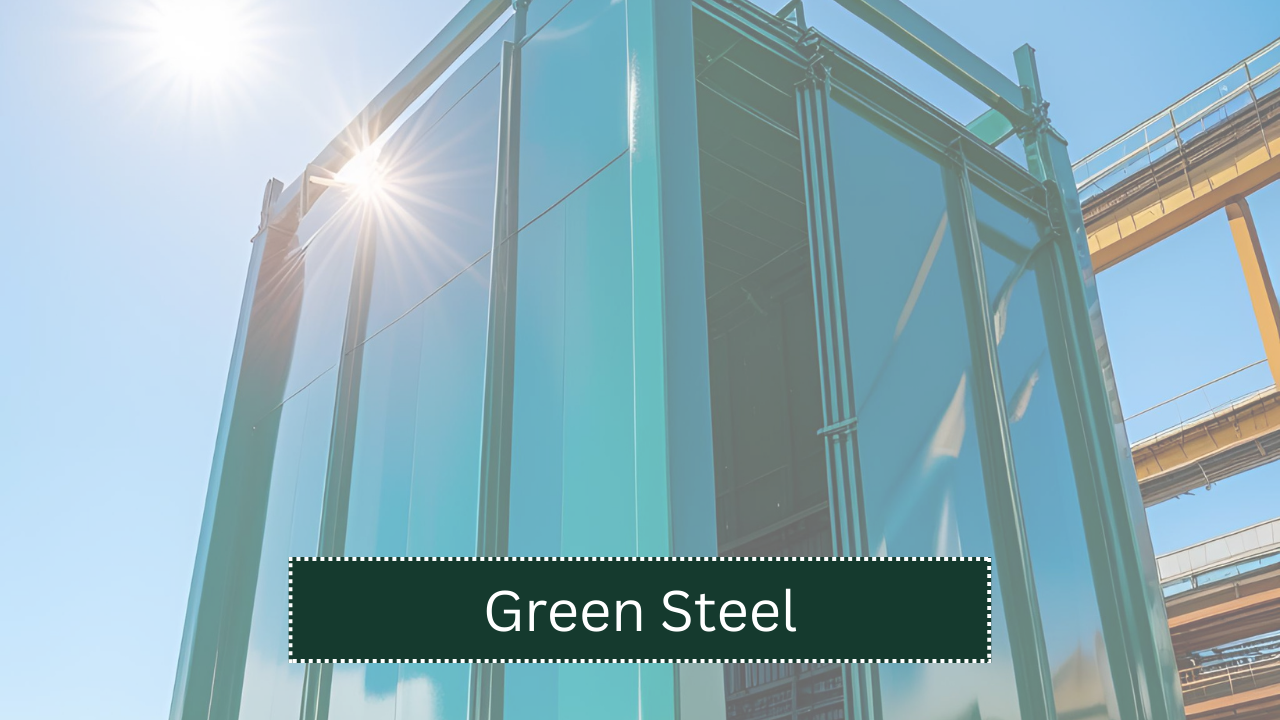Steel plays an important role in industries such as construction, automotive, and infrastructure. However, traditional steel manufacturing causes heavy pollution due to high carbon dioxide (CO₂) emissions. As the world shifts towards sustainability and greener technologies, “Green Steel” has emerged as a promising alternative for reducing the environmental impact of steel production.
Introduction to Green Steel
Green steel refers to steel that is produced using low-emission processes. These methods avoid or reduce fossil fuel usage and replace them with clean energy sources such as hydrogen, electricity from renewable sources, or carbon capture technologies. The aim is to produce steel without harming the environment.
Why Green Steel is Important
Environmental Impact of Traditional Steel:
- High Carbon Emissions: Producing one ton of steel can release around 1.85 tons of CO₂.
- Heavy Use of Coal: Traditional methods like the blast furnace process use coke (a coal product), which pollutes air and water.
- Resource-Intensive: Steel production requires a lot of water, energy, and raw materials.
Need for Sustainable Solutions:
- The world is focusing on achieving net-zero emissions by 2050.
- Green steel can help reduce the carbon footprint of industries.
- Eco-friendly steel can attract green investors and align with global climate goals.
Key Methods of Producing Green Steel
| Production Method | Description | Benefits |
|---|---|---|
| Hydrogen-Based Steelmaking | Uses hydrogen instead of coke to reduce iron ore. | No CO₂ emissions if green hydrogen is used. |
| Electric Arc Furnace (EAF) | Melts scrap steel using electricity, especially from renewable sources. | Reuses materials, low emissions. |
| Carbon Capture and Storage (CCS) | Captures CO₂ emissions and stores them underground. | Allows existing plants to reduce pollution. |
| Direct Reduced Iron (DRI) | Produces steel using gases like natural gas or hydrogen. | Less carbon-intensive than blast furnaces. |
Hydrogen in Green Steel Production
Hydrogen plays a vital role in the future of green steel. When used instead of coke in the reduction process, hydrogen releases water vapor instead of CO₂. This is why many companies are investing in hydrogen-based steel plants.
Types of Hydrogen Used:
| Type of Hydrogen | Source | Eco-Friendliness |
|---|---|---|
| Green Hydrogen | Produced using renewable electricity and water. | 100% clean and sustainable. |
| Blue Hydrogen | Made from natural gas with CO₂ capture. | Low emissions but not zero. |
| Grey Hydrogen | Made from fossil fuels without capturing CO₂. | High emissions, not sustainable. |
Only green hydrogen is truly eco-friendly and suitable for sustainable steel production.
Top Companies Leading Green Steel Initiatives
Several global steel manufacturers and startups have launched green steel projects. These companies are investing in advanced technologies to reduce carbon output.
| Company | Country | Green Initiative |
|---|---|---|
| SSAB | Sweden | HYBRIT – hydrogen-based steel project. |
| ArcelorMittal | Luxembourg | Smart Carbon and DRI projects. |
| Tata Steel | India | Working on hydrogen-based steel in Jamshedpur. |
| H2 Green Steel | Sweden | Building a fully green steel plant using hydrogen. |
| POSCO | South Korea | Developing hydrogen-based production lines. |
Benefits of Green Steel
Switching to green steel offers multiple advantages for the environment, businesses, and consumers.
Environmental Benefits:
- Reduces greenhouse gas emissions.
- Protects air and water quality.
- Helps slow down global warming.
Economic and Social Benefits:
- Opens new markets for green products.
- Attracts environmentally-conscious customers.
- Supports global climate agreements like the Paris Accord.
- Creates new jobs in renewable energy and technology sectors.
Challenges in Adopting Green Steel
Despite its potential, green steel faces several challenges:
| Challenge | Explanation |
|---|---|
| High Costs | Green hydrogen and renewable electricity are expensive. |
| Infrastructure Needs | New plants or retrofitting old ones require large investments. |
| Limited Supply | Green hydrogen is still not widely available. |
| Technological Readiness | Some green technologies are still in development or early testing stages. |
Governments and private sectors need to invest heavily in innovation, policy support, and funding to make green steel affordable and accessible.
Government Support and Global Policies
Many countries are now encouraging green steel through:
- Carbon taxes to make polluting steel costlier.
- Incentives and subsidies for green technology use.
- Green public procurement, where governments buy only eco-friendly steel.
- International collaborations to share knowledge and fund joint projects.
Policy Examples:
| Country | Policy/Program | Focus Area |
|---|---|---|
| European Union | Green Deal | Net-zero emissions by 2050, funding green steel. |
| Germany | H2Global | Promotes hydrogen-based industries. |
| India | National Green Hydrogen Mission | Boosts hydrogen use in steel and other sectors. |
| USA | Inflation Reduction Act | Tax credits for clean energy and industrial innovation. |
Green Steel in India
India is the second-largest producer of steel and has a big opportunity to lead the green steel movement. Initiatives like the National Green Hydrogen Mission aim to develop the technology and supply chain required for clean steel production. Indian steel companies are also exploring the use of solar and wind energy to power electric arc furnaces.
Comparison: Traditional Steel vs Green Steel
| Aspect | Traditional Steel | Green Steel |
|---|---|---|
| CO₂ Emissions | High | Very Low or Zero |
| Fuel Used | Coal/Coke | Hydrogen or Electricity |
| Production Cost | Lower (currently) | Higher (but decreasing) |
| Impact on Climate | Harmful | Eco-Friendly |
| Scalability | Fully developed | Still growing |
Future Outlook for Green Steel
The future of steel lies in sustainability. As technology advances and production costs fall, green steel will become more common. With growing consumer demand for sustainable materials and stricter government rules, companies will be pushed to adopt cleaner methods. By 2030–2040, green steel may become the global standard for construction, transportation, and manufacturing.
Moving Forward
Green steel represents a significant step towards a cleaner, more sustainable future. While the journey involves challenges like high costs and infrastructure needs, the long-term benefits for the planet and the economy are clear. With strong government support, industry innovation, and public awareness, green steel has the potential to revolutionize the way we build our world without damaging the environment.

